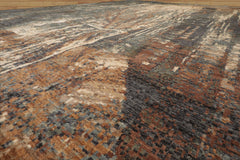

















Gray 10'x14' Hand-Knotted Tibetan Wool & Silk Modern Area Rug
- $4,499.99
$13,499.97- $4,499.99
- Unit price
- per
- Exact Size: 10' x14'
- Weave: Hand Knotted Rug
- Yarn: Wool & Silk
- Color: Gray, Beige, Charcoal, Tan, Brown, Multi
- Origin: India
- Pile Height: 0.5 inch
- Condition: New
- Condition Description: New with tags
- Rug#: AOR19217
For centuries, Tibetans have crafted rugs for both decorative and practical uses, drawing inspiration from geometric patterns, auspicious symbols, mythical and real animals, and nature to create vibrant, intricate designs. However, it wasn’t until after the 1959 Chinese invasion of Tibet and the subsequent Tibetan diaspora in Nepal and India that the art of Tibetan rug weaving saw a significant commercial revival. During the 1970s, Tibetan rugs gained international recognition, with Nepalese artisans stepping in to meet the growing demand, becoming essential to preserving the Tibetan weaving tradition. While most Asian rugs use either the Turkish knot or Persian knot (Senneh knot) to create their pile, Tibetan rugs employ a unique slit-loop method known as the Tibetan knot. This technique involves wrapping continuous yarn over a rod placed across the warp threads of a loom. Once the rod is fully wrapped, the yarn is cut along its length with a knife, producing two rows of pile tufts. The resulting texture is a luxurious combination of depth, richness, and texture. Traditional Tibetan rug designs often reflect Buddhist religious themes, while motifs of Chinese origin, such as dragons, phoenixes, and lotus flowers, have been incorporated into the regional rug artistry. Today, Tibetan and Nepalese rugs, along with Indo-Tibetan creations from India, feature designs that range from Westernized versions of traditional motifs like snow lions and floral branches to a variety of modern, freeform patterns.
Related Products
- $4,499.99
$13,499.97- $4,499.99
- Unit price
- per
- $4,499.99
$13,499.97- $4,499.99
- Unit price
- per
- $4,499.99
$13,499.97- $4,499.99
- Unit price
- per
- $4,499.99
$13,499.97- $4,499.99
- Unit price
- per
- $4,499.99
$13,499.97- $4,499.99
- Unit price
- per
- $4,499.99
$13,499.97- $4,499.99
- Unit price
- per
- $4,499.99
$13,499.97- $4,499.99
- Unit price
- per
- $4,499.99
$13,499.97- $4,499.99
- Unit price
- per
- $4,499.99
$13,499.97- $4,499.99
- Unit price
- per
- $4,499.99
$13,499.97- $4,499.99
- Unit price
- per
- Choosing a selection results in a full page refresh.

